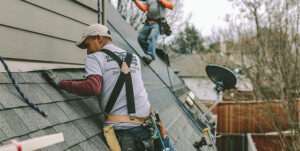A well-maintained air conditioning system is more efficient and costs less to run. It also reduces the risk of a breakdown on one of those steamy, humid days.
Performing routine AC maintenance is simple. First, clean the drain line. It’s a 1-inch PVC pipe that exits the evaporator enclosure. If you have any questions about what an air conditioning maintenance appointment entails, contact All Temp Air Conditioning & Refrigeration experts.
 Inspect the Condenser
Inspect the Condenser
The evaporator and condenser units are the heart of your cooling system. They are usually found outside your home or business and have copper tubes, sometimes covered in a foam layer, running from it to your air handling unit inside the house.
These tubes are filled with refrigerant, which is what makes your AC cool by the process of heat transfer. When the refrigerant is low or leaking, you may notice that your system isn’t working as it should. During an inspection, your technician will test the refrigerant levels and refill it as needed.
They will also check for any signs of leakage and wear and tear on your compressor and fan. If they see any issues that need addressing, your technician will make repairs or replacements to keep the system working properly.
During the inspection, your HVAC contractor will also lubricate moving parts to prevent them from causing unnecessary friction that can shorten their lifespan. This is an important step because a lack of lubrication can lead to damage that increases the frequency and severity of future repairs.
Your HVAC technician will also clear the condensation drain line if it becomes clogged or leaks. The drain line carries water away from the condenser and may have an access point or exit point, both of which need to be cleaned regularly. The technician will flush the drain line by pouring a mixture of hot water and vinegar into it to clean it out. They will also check for the presence of mold and bacteria around the condensate drain pan and if necessary will clean or replace it.
In addition to these more obvious tasks, your HVAC professional will inspect the condenser fan for wear and tear, ensure that there is enough clearance around the unit, and check the condition of the coils. They will also clean the outdoor fan motor and fan blades, as well as the electrical connections and wiring. They will also check the safety limit switches, and if necessary, tighten any loose ones.
Inspect the Evaporator
The evaporator coil inside your air handler absorbs heat from the air. Over time, the coil can become dirty, which reduces the amount of heat it absorbs. This problem can lead to cooling problems and high energy bills. A professional HVAC technician can clean the evaporator coil for you.
Cleaning the evaporator coil is one of the most important maintenance tasks for your AC. You can do this job yourself, but it’s a good idea to have a professional service technician inspect and clean the coil at least once a year.
Over time, the aluminum fins on the evaporator and condenser coils can bend. This reduces airflow and increases pressure on the coil. It also causes dirt to collect more quickly, and this dirt reduces the coil’s ability to absorb heat from the air. A cleaning spray or a fin comb can restore these fins to their original condition.
Another important air conditioning maintenance task is replacing or cleaning the filter. Dirty filters prevent the evaporator coil from absorbing heat from the air, and this can lead to low efficiency. You should replace or clean your air filter at least every three months.
An inspection includes checking the evaporator coil for signs of damage or excessive wear and making sure that it’s properly insulated. The service technician will also check the refrigerant line for leaks or corrosion and inspect the drain pan for signs of mold or ice.
A final maintenance task is to clear the evaporator coil drain line regularly. This involves finding the drain line, usually a 1-inch PVC pipe coming off the evaporator enclosure, and following it to where it drains. Then you can use a wet/dry vacuum or a pipe cleaner to remove any debris that’s clogging the line. It’s also a good idea to add a drain pan tablet (available from your local hardware store) to the line to help prevent algae growth that can block the line. This will keep the line from becoming clogged and prevent the coil from draining excess condensation.
Inspect the Ductwork
The ductwork of your home is a maze of tubes that delivers heated and cooled air to the different rooms in your house. During your air conditioning maintenance, an experienced technician will take a close look at all the ducts in your home. In addition to checking the condition of the insulation and sealing the leaks, he or she will also inspect the blower unit for proper function.
Ducts that have not been maintained over time can become clogged with dust, dirt, and debris. This impedes airflow and causes the AC system to work harder, which leads to higher utility bills.
In addition, a clogged or damaged duct can allow pollen and other allergens to circulate throughout the house. As a result, breathing these contaminants can trigger allergies and respiratory issues in some people. Regular duct cleaning and inspection can prevent these problems.
Your home’s ductwork may be located in the attic, in crawl spaces, or the walls of your house. Depending on the location, it may be difficult for you to access the ducts or for an HVAC professional to conduct a thorough inspection.
When you’re due for an AC maintenance visit, walk along the length of the ductwork to see if it has any obvious leaks. A leak in the ductwork allows conditioned air to escape into the attic space and unconditioned air to enter living spaces.
Leaking ducts can be easily repaired by using aluminum foil tape or mastic sealant. However, it’s important to ensure that the duct leak area is clean before applying the tape or mastic. Otherwise, the air leakage will recur once it’s applied.
In homes with insulated ducts, it’s recommended to use a UV light to sterilize the air in the ducts. This technology uses ultraviolet radiation to destroy bacteria, mold, and fungal spores. This can reduce the number of fungi in the ductwork and improve indoor air quality. In addition, a UV light can help extend the life of your ductwork. This is particularly true if you’re considering replacing your ducts shortly.
Inspect the Thermostat
The thermostat is an important component of any air conditioning system. It controls how much energy is used by the system, and it also sets the temperature that will be delivered throughout the home or office. The HVAC technician will inspect the thermostat during the maintenance appointment, and they will calibrate it as well. This is an important step because a thermostat that is not properly calibrated will not be able to deliver the correct temperature throughout the space.
The HVAC technician will also test the voltage of the unit, look for signs of damage and other issues, and clean various parts like the compressor, evaporator coils, air handler, drainage line, and vents. They will also check the refrigerant levels and observe how the system functions through a complete cycle. They will also inspect the outdoor condenser unit and ductwork, and they may lubricate any ports that are present.
It is important to get air conditioning maintenance because it can help you save money on your energy costs and keep the air in your home or office cleaner. It can also catch problems that may be expensive to fix if they are not caught early on. The HVAC specialists know how to perform maintenance on your system and can keep it running for a long time.
The specialized tools that an HVAC technician has will allow them to do a thorough inspection of your system. This includes looking at the condensate drain lines, which can become clogged and cause leaks. The HVAC technician will also examine the venting and heat exchanger, and they will test for carbon monoxide leaks in your house. A yearly maintenance appointment is essential to keeping your system running efficiently and preventing costly repairs. The technicians will be able to answer your questions and provide you with a schedule for your annual maintenance appointments. This will make it easier for you to keep up with your maintenance. Then, you can enjoy a more comfortable home or office for years to come!






